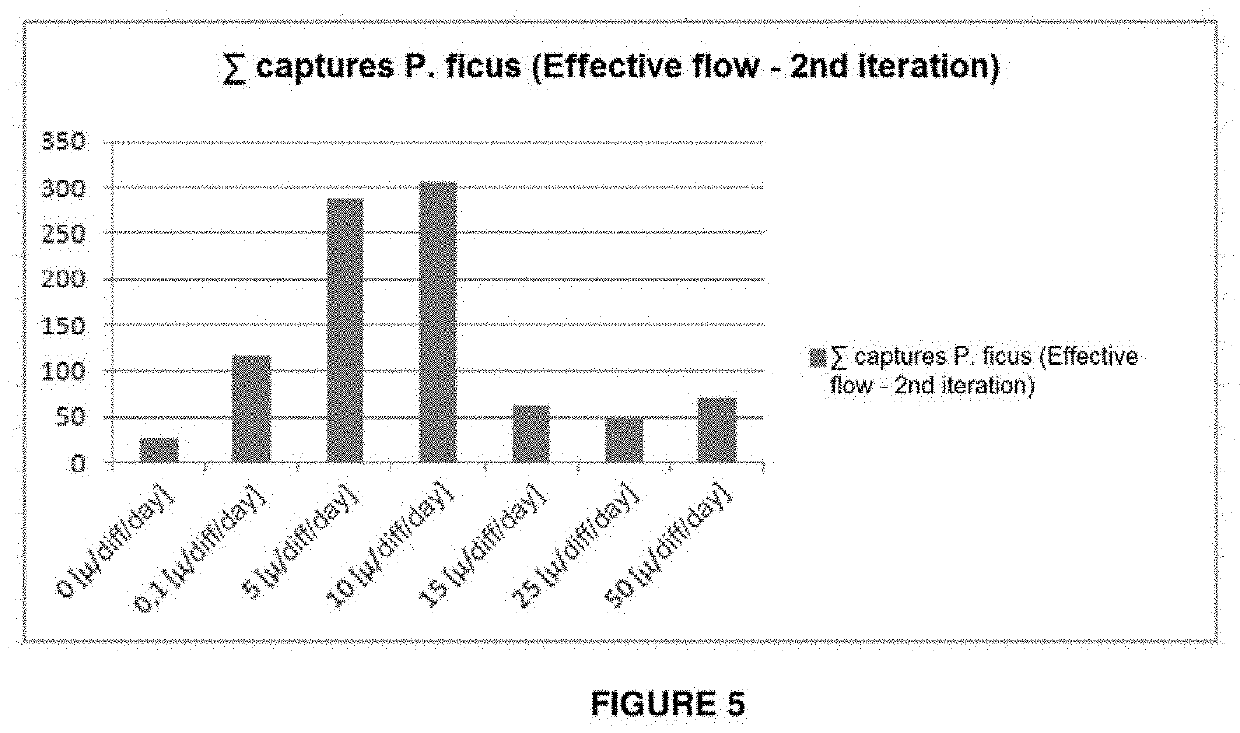Method for effectively controlling coccoid insect pests
- Summary
- Abstract
- Description
- Claims
- Application Information
AI Technical Summary
Benefits of technology
Problems solved by technology
Method used
Image
Examples
example 1
Obtainment, Selection and Use of an Artificial Semiochemical Matrix to Combat the Coccoid Pest A. aurantii, in Citrus Crops
[0092]1.a. Obtainment and selection of the effective flow for attracting A. aurantii males, within the interlinked semiochemical matrix.
[0093]Experiments for obtaining an effective flow to combat the diaspidid Aonidiella aurantii were carried out on citrus crops located in the province of Huelva in 2015 and 2016.
[0094]For these assays, four plots of different varieties of citrus trees with surface areas comprised between 2 and 10 hectares were initially taken.
[0095]An artificial semiochemical matrix 1 was generated therein by arranging 500 diffusers / ha, with a substantially constant initial emission flow-1 of 300 μg / diffuser / day (optimal flow according to the state of the art) of (3S,6RS)-3-methyl-6-isopropenyl-9-decen-1-yl acetate.
[0096]In the interior of these artificial semiochemical matrices, two blocks of seven diffusers with different emission flows were i...
example 2
Obtainment, Selection and Use of an Artificial Semiochemical Matrix to Combat the Planococcus Ficus Coccoid Pest in Table Grape Crops
[0129]2.a. Obtainment and Selection of the Effective Flow for Attracting P. ficus Males, within the Interlinked Semiochemical Matrix
[0130]The response of the males of the species P. ficus, at different emission flows of senecioate S-lavandulyl, was evaluated in various field tests carried out on table grape crops located in the Municipal District of Alhama de Murcia and Totana, both municipalities in the Region of Murcia in 2015, 2016 and 2017.
[0131]For these assays, four plots of different varieties of table grapes with surface areas comprised between 1 and 4 hectares were initially taken. An artificial semiochemical matrix-1 was generated therein through the installation of 1,000 diffusers / ha, with a substantially constant emission flow of 300 μg / day of S-lavandulyl senecioate (initial flow-1). The choice of this initial emission flow is based on the...
PUM
 Login to View More
Login to View More Abstract
Description
Claims
Application Information
 Login to View More
Login to View More - R&D
- Intellectual Property
- Life Sciences
- Materials
- Tech Scout
- Unparalleled Data Quality
- Higher Quality Content
- 60% Fewer Hallucinations
Browse by: Latest US Patents, China's latest patents, Technical Efficacy Thesaurus, Application Domain, Technology Topic, Popular Technical Reports.
© 2025 PatSnap. All rights reserved.Legal|Privacy policy|Modern Slavery Act Transparency Statement|Sitemap|About US| Contact US: help@patsnap.com



